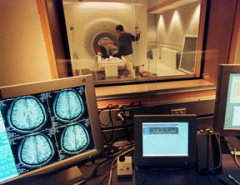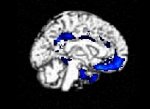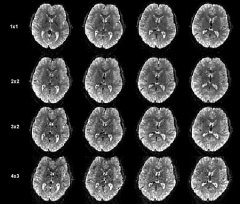This week yielded some amazing reports on brain research, from diagnosing injury before the symptoms manifest to tracking emotional behavior to specific little gray cells. Here are just a few:
The serious consequences of a blow to the head, and a possible test. Most people know the insidious consequences of a knockout or a concussion, the worst case scenario being a blood clot that leads to a stroke. Less understood are consequences of blows to the head—direct or percussive, like from being too near an explosive device—that leave you reeling, but conscious. If you’re not out cold, the layman reasoning goes, you’re OK.
But as NFL helmet lawsuits, post-traumatic stress disorders (PTSD) in veterans, and the living example of Muhammed Ali show, there are long-term consequences to repeated knocks. The Center for the Study of Traumatic Encephalopathy, which focuses on progressive degenerative brain disease, points out that this has been recognized in boxers since the 1920s. Unfortunately, diagnoses don’t happen until literally long after damage has been done.
However, a project launched last year in Nevada—the Professional Fighters Brain Clinical Research Study—has looked into the gray matter of more than 100 mixed martial artists and boxers with compelling results already: MRI scans might reveal injuries before symptoms show.
The physical changes, detected by MRI scans, are a reduction in size in the hippocampus and thalamus of the brains of fighters with more than six years in the ring. These parts of the brain deal with such functions as memory and alertness. While those who had fought for more than six years did not exhibit any declines in cognitive function, fighters with more than 12 years in the ring did. Thus, Dr. Bernick’s group concluded, the lag between detectability and physical symptoms probably occurs sometime during those six years. (April 24, The New York Times)
This could have far-reaching repercussions for disorders like Alzheimer’s or PSTD, especially given our burgeoning veteran population, 30% of which have been diagnosed with PSTD, brain injuries, or depression. Connecting such problems with physical injury might also help alleviate the stigma surrounding them.
[T]he increased military and media attention given to post-traumatic stress disorder and traumatic brain injury has had the effect of stigmatizing veterans, advocates say. Some employers fear that soldiers diagnosed with these conditions are prone to violence or instability. (April 25, The Los Angeles Times)
Where your emotions originate in your brain. How about pinpointing in your noggin where your feelings and actions arise? “The Emotional Life of Your Brain,” published in March, takes the lessons learned in affective neuroscience and correlates six emotional styles with brain activity.
- resilience (capacity to recover from adversity)—prefrontal cortex, amygdala
- outlook (glass half empty or half full)—ventral striatum
- sensitivity to context (what situation are they operating in, and do they adapt)—hippocampus
- sensitivity to social cues (facial expressions, tones of voice)—amygdala, fusiform
- sensitivity to internal bodily cues (how one feels, self-awareness)—visceral organs
- attention (scattered, focus)—prefrontal cortex
In an interview with Forbes, University of Wisconsin-Madison professor Richard Davidson explains what’s new about these psychological models.
“Other schemes of personality were invented without any knowledge of the brain,” says Davidson, who compiled his 30 years of research findings into new book The Emotional Life of Your Brain. “This is the first neuroscientific conception of the emotional and social variations among people, based on a modern diagnosis of the brain.” (April 26, Forbes)
And if you’re wondering, yes, you can rewire your brain. Lucky for us, Davidson says, “Neuroplasticity, the brain’s ability to reorganize, is the organ of change.” Both the Forbes interview and his book give tips on pumping up where you might be lacking.
Finding how to stop extreme behavior. Thanks to crime literature and serial killer movies, Americans are aware of many different “-paths”: sociopath, psychopath, and antisocial personality disorder. What has been a raging debate is if one is doomed to that diagnosis and basically lifetime incarceration, or if there’s a window of intervention. One researcher went on a roadtrip into the heart of darkness: Using a mobile MRI unit, a University of New Mexico associate professor of psychology took a snapshot of 2,000 inmate volunteers.
He found that compared to the average offender, 60 percent of psychopaths re-offend within the next 200 days. Maximum-security juveniles showed a similar pattern: 68 percent of individuals who were at high risk for psychopathy re-offended.
Using images of the brain, [Kent] Kiehl said he could predict psychopathy as well as one can with clinical error. (April 23, Duke (University) Research Blog)
Among preliminary findings, Kiehl zeroed in on the interaction with a gene (MAOA) and a “stressful” upbringing and that treatment like group therapy actually ends in “violent failure” among adults. For juveniles, intervention’s a different story and can show a 50% reduction in violent recidivism.
“We have a problem in the United States: We incarcerate a lot of people,” he said. “We incarcerate more per capita than any other country. It’s expensive—it costs $2.34 trillion per year, which is about the same as the annual estimate for all health care [in the country].” (April 23, Duke (University) Research Blog)
Controlling the world around them. Scientists—and science fiction writers—have long envisioned a world in which people can control the objects around them simply with their thoughts. On April 24, the Institute of Technology in Lausanne, Switzerland, placed a cap on Mark-Andre Duc, a partial quadriplegic.
Duc’s thoughts—or rather, the electrical signals emitted by his brain when he imagined lifting his paralyzed fingers—were decoded almost instantly by a laptop at the hospital. The resulting instructions—left or right—were then transmitted to a foot-tall robot scooting around the Lausanne lab. (April 24, Associated Press)
There are actually toys like Mindflex that play on this technology. The Swiss experiment, though, is a first with a disabled person. While the test showcased failures in system (losing focus will “degrade the signal”), the future in which someone can have a “virtual presence” outside his or place of confinement now lies only a few years away.
“Silly” research pays important dividends. One moment, you’re lapping at a scoop of balsamic strawberry ice cream, the next minute your mind is locked up and your face scrunched in fleeting agony. Ah, the brain freeze. Researchers from Harvard University, the University of Ireland, and the Department of Veterans’ Affairs delved into this delicious excruciation known as sphenopalatine ganglioneuralgia: Volunteers didn’t have the pleasure of ice cream but ice water, and transcranial Doppler measured a rush of blood to the anterior cerebral artery, the part of the brain that funnels oxygen to the frontal lobe.
Theory? The cold signal tells the brain to keep itself warm, and the rush of blood builds up pressure that can lead to a headache. This research could help explain migraines and those related to PSTD.




 MRI brain scan
MRI brain scan